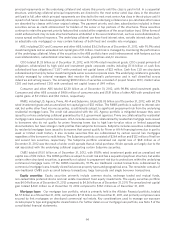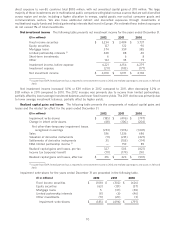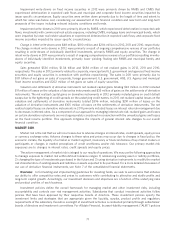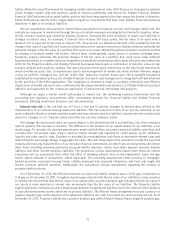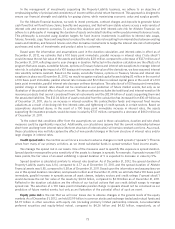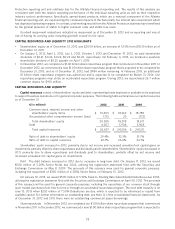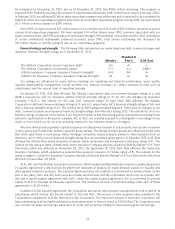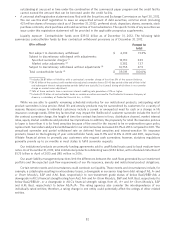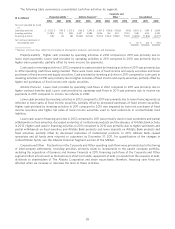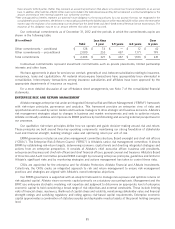Allstate 2013 Annual Report Download - page 192
Download and view the complete annual report
Please find page 192 of the 2013 Allstate annual report below. You can navigate through the pages in the report by either clicking on the pages listed below, or by using the keyword search tool below to find specific information within the annual report.The change in the discount rate increased the net actuarial loss by $806 million, $407 million, and $166 million in
2012, 2011 and 2010, respectively. The difference between actual and expected returns on plan assets (decreased)
increased the net actuarial loss by $(201) million, $100 million, and $(164) million in 2012, 2011 and 2010, respectively.
Net periodic pension cost in 2013 is estimated to be $333 million based on current assumptions, including
settlement charges. This represents an increase compared to $266 million in 2012 due to an increase in the
amortization expense for prior years net actuarial losses (gain) which increased due to a lower discount rate used to
value the pension plans. Net periodic pension cost decreased in 2012 compared to $304 million in 2011 primarily due to
an increase in the expected return on plan assets, a lower discount rate used to value the pension plans and a decrease
in settlement charges partially offset by increased amortization of net actuarial loss (gain). Net periodic pension cost
decreased in 2011 compared to $345 million in 2010 primarily due to an increase in the expected return on plan assets.
In 2012, 2011 and 2010, net pension cost included non-cash settlement charges primarily resulting from lump sum
distributions made to agents. Settlement charges also occurred during 2012, 2011 and 2010 related to the Supplemental
Retirement Income Plan as a result of lump sum payments made from the plan. Settlement charges are likely to continue
for some period in the future as we settle our remaining agent pension obligations by making lump sum distributions to
agents.
Since December 31, 2007, unrecognized pension benefit cost, pre-tax, has increased approximately $2 billion,
approximately one third of which arose from asset returns differing from expected returns and approximately two thirds
of which is related to changes in the discount rates which have been declining over this period. As of December 31, 2012,
the discount rate had declined over the last five years from 6.5% to 4.0%, due to the decline in the weighted average
yields of the investments that qualify for consideration to establish the assumption for the discount rate. Also, plan
assets sustained net losses in 2008 primarily due to declines in equity and credit markets.
These changes in discount rates and prior year asset losses, combined with all other unrecognized actuarial gains
and losses, resulted in a net actuarial loss of $2.89 billion and amortization of net actuarial loss (and additional net
periodic pension cost) of $178 million in 2012 and $153 million in 2011. We anticipate that the net actuarial loss for our
pension plans will exceed 10% of the greater of the PBO or the market-related value of assets in 2013 and into the
foreseeable future, resulting in additional amortization and net periodic pension cost. The net actuarial loss will be
amortized over the remaining service life of active employees (approximately 9 years) or will reverse with increases in
the discount rate or better than expected returns on plan assets.
Amounts recorded for net periodic pension cost and accumulated other comprehensive income are significantly
affected by changes in the assumptions used to determine the discount rate and the expected long-term rate of return
on plan assets. The discount rate is based on rates at which expected pension benefits attributable to past employee
service could effectively be settled on a present value basis at the measurement date. We develop the assumed discount
rate by utilizing the weighted average yield of a theoretical dedicated portfolio derived from non-callable bonds and
bonds with a make-whole provision available in the Bloomberg corporate bond universe having ratings of at least ‘‘AA’’
by S&P or at least ‘‘Aa’’ by Moody’s on the measurement date with cash flows that match expected plan benefit
requirements. Significant changes in discount rates, such as those caused by changes in the credit spreads, yield curve,
the mix of bonds available in the market, the duration of selected bonds and expected benefit payments, may result in
volatility in pension cost and accumulated other comprehensive income.
Holding other assumptions constant, a hypothetical decrease of 100 basis points in the discount rate would result in
an increase of $51 million in net periodic pension cost and a $503 million increase in the unrecognized pension cost
liability recorded as accumulated other comprehensive income as of December 31, 2012, compared to an increase of
$52 million in net periodic pension cost and a $427 million increase in the unrecognized pension cost liability as of
December 31, 2011. A hypothetical increase of 100 basis points in the discount rate would decrease net periodic pension
cost by $45 million and would decrease the unrecognized pension cost liability recorded as accumulated other
comprehensive income by $421 million as of December 31, 2012, compared to a decrease in net periodic pension cost of
$46 million and a $360 million decrease in the unrecognized pension cost liability recorded as accumulated other
comprehensive income as of December 31, 2011. This non-symmetrical range results from the non-linear relationship
between discount rates and pension obligations, and changes in the amortization of unrealized net actuarial gains and
losses.
The expected long-term rate of return on plan assets reflects the average rate of earnings expected on plan assets.
While this rate reflects long-term assumptions and is consistent with long-term historical returns, sustained changes in
the market or changes in the mix of plan assets may lead to revisions in the assumed long-term rate of return on plan
assets that may result in variability of pension cost. Differences between the actual return on plan assets and the
76


